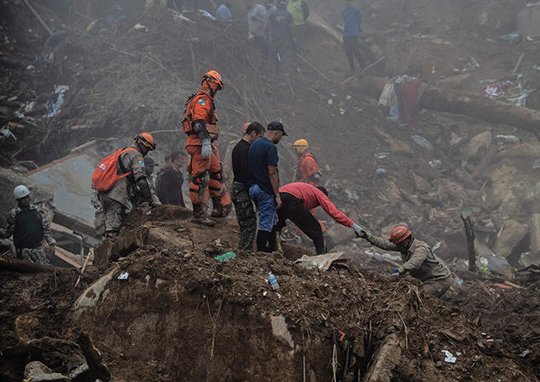Climate change is causing grievous harm and growing costs to nature and people around the world, according to scientists in the latest United Nations Intergovernmental Panel on Climate Change report. They also warned that there are limits in the ability of people and nature to adapt and that those most affected are vulnerable communities with the least resources to cope with the impacts of climate change.
Following is a statement from Manish Bapna, president and CEO of NRDC (Natural Resources Defense Council):
“This is a high-definition map of global misery. Millions of people are facing acute food and water insecurity. Economies are constrained. Disease and death are rising. And those suffering most are low-income populations – as many as 3.6 billion people - on the jagged frontlines of climate hazard and harm.
“It’s time for urgent action. ”
Climate impacts are here and getting worse—so we can and must adapt starting now.
 Rescue workers at the scene of a giant landslide in Petropolis, Brazil, three days after a historic storm that left at least 122 dead and covered entire neighborhoods with mud, on February 18, 2022. Carl De Souza/AFP via Getty Images .
Rescue workers at the scene of a giant landslide in Petropolis, Brazil, three days after a historic storm that left at least 122 dead and covered entire neighborhoods with mud, on February 18, 2022. Carl De Souza/AFP via Getty Images .
“ The key takeaway is that we can and must take a wide range of climate actions available to us right now in order to deal with the climate crisis head-on, ” Juanita Constible, Senior Advocate, Climate and Health, Climate & Clean Energy Program of NRDC, said in her blog.
Already, some natural systems and communities have run up against limits of responding to climate change. Some of those limits are “soft,” meaning adaptation options may exist, but aren’t currently available. Soft limits, such as a lack of financing, can be overcome with political will, international collaboration, and by tackling the root causes of wealth inequality. But other limits are “hard,” meaning that “no adaptive actions are possible to avoid intolerable risks.” Examples of hard limits include the collapse of fisheries dependent on coral reefs that are already experiencing unlivable heat. Our collective failure to drastically reduce the pollution causing climate change and urgently reduce our climate risks through adaptation will calcify many of the limits that are now soft into irreversible barriers to a livable and sustainable future.
 A bird protecting its nest on the floor of the boreal forest in northwestern Ontario, Canada, June 2019. River Jordan for NRDC.
A bird protecting its nest on the floor of the boreal forest in northwestern Ontario, Canada, June 2019. River Jordan for NRDC.
“One of the impacts that is most evident and growing most quickly is sea level rise,’’ Rob Moore, Senior Policy Analyst, Healthy People & Thriving Communities Program, said in his blog. By mid-century, one billion people will be exposed to much greater risks of flooding due to sea level rise. That exposure will result either from extreme weather, storm surges that roll in on the rising oceans, increased tidal flooding, or worse, permanent inundation. According to the IPCC, “this exposed population doubles at a 0.75m (2.5 feet) rise in mean sea level and triples at 1.4 m (4.6 feet) without population change and additional adaptation.” (see Summary for Policy Makers B.4.5)
The IPCC makes it absolutely clear that no amount of emissions reduction can stop the near and mid-term impacts of sea level rise. But emissions reductions have enormous implications for how fast and how far sea levels will rise, particularly in the second half of this century and beyond. That’s why nations, including the United States, must place high priority on both climate adaptation and climate mitigation efforts.

